List of Authors
>>About this blog
Recent blog posts
|
[Sam]
14:00 on November 23, 2016
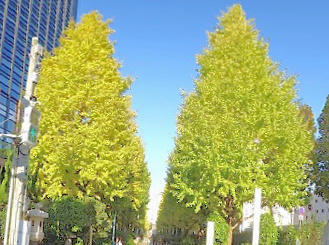 The yellow leaf front of the ginkgo, which has advanced from the north, also reached Tokyo. The yellow leaf front of the ginkgo, which has advanced from the north, also reached Tokyo.
On November 21, the Tokyo Regional Meteorological Observatory reported one of the Japan Meteorological Agency's biological seasonal observation information "Ginkgo Yellow Leaves".
It is one day later than normal and nine days earlier than last year.
The yellow leaf day of ginkgo is the first day when most leaves turn yellow when looking at the standard Kimata body.
The standard tree in Tokyo is the so-called "earthquake ginkgo" that escaped the fire caused by the  Great Kanto Earthquake in the Omote moat green area (commonly known as Kiyomaro Park) at the northeastern end of the Imperial Palace. Great Kanto Earthquake in the Omote moat green area (commonly known as Kiyomaro Park) at the northeastern end of the Imperial Palace.
The ginkgo on the green road at Hamacho Park entrance is also completely colored and is in full bloom.
The leaves are exposed to the soft sunlight, shining golden, and you can experience the deepening autumn.
I heard that the yellow leaves of ginkgo in Tokyo tend to be delayed year by year, and in recent years it has been more than half a month later than 50 years ago.
It seems that one of the causes is that the coldness of the morning and evening has weakened compared to the past.
[Sam]
14:00 on November 20, 2016
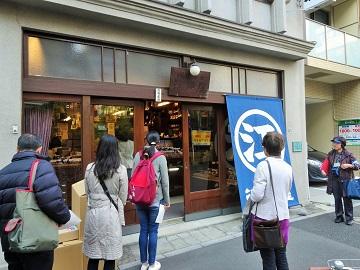 On November 17, the Chuo-ku Machikado Exhibition Hall Tour-Experience the state-of-the-art world of medicine and the long-established tradition-hosted by the Chuo-ku Machikado Exhibition Hall Management Council was held. On November 17, the Chuo-ku Machikado Exhibition Hall Tour-Experience the state-of-the-art world of medicine and the long-established tradition-hosted by the Chuo-ku Machikado Exhibition Hall Management Council was held.
Schedule:
Visit to Daiichi Sankyo Medicine Museum ~
Visit to Edoya's brush exhibition hall
Visit to Iba Senukiyoe Museum
The journey on the way to the destination is a city guide by Chuo-ku cultural property supporters.
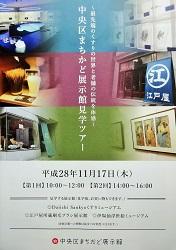 At the Daiichi Sankyo Medicine Museum, after watching a video of "one medicine" on a round monitor in the center of the lounge on the 1st floor, you will receive a medal with an IC chip and go to the 2nd floor. At the Daiichi Sankyo Medicine Museum, after watching a video of "one medicine" on a round monitor in the center of the lounge on the 1st floor, you will receive a medal with an IC chip and go to the 2nd floor.
Medals are used to see, hear, touch and experience the corners of "Cickle and Nihonbashi", which introduces the deep relationship between tickle and Nihonbashihoncho, as well as "Cickle to body", "Cickle action", "Ayumi of medicine", and "Create medicine".
At the Edoya-owned brush exhibition hall, you can experience the brush as a traditional craft designated by Tokyo, as well as exhibits such as Hanko made with horse hair. The makeup brush of squirrel hair has an amazing soft touch.
At the Ibasen Ukiyo-e Museum next to the Ibasen Store, you will see the "Ibasen version Tokaido 53 Tai" currently on display.
At the same time, we will talk about the ukiyo-e print production process, etc. based on the division of labor system of publishers, painters, sculptors, and printers who play the role of producers.
This is a mini tour that gives you a glimpse of a part of the local cultural resources.
[Sam]
12:00 on November 19, 2016
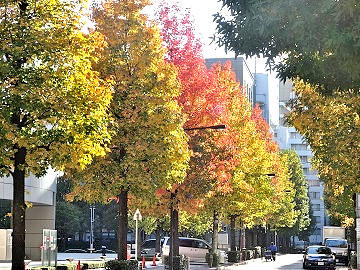 November is also in the middle of November, and the morning and evening are colder day by day, and the Kiki gradually turns color, and it is at their best. November is also in the middle of November, and the morning and evening are colder day by day, and the Kiki gradually turns color, and it is at their best.
This time, we featured in the ward in front of IBM Hakozaki Building in Nihonbashihakozakicho, where Mobijibafu (aka United States Fu) is planted along with Akashicho Green Road and Ningyocho-dori St. (North side of Ningyocho Intersection), along with Mobijibafu (also known as Fu) is planted in the ward.
The deciduous Takagi of the genus Mansaku, which is said to be native to North America, Central and South America, although its leaf shape resembles a maple leaf shape.
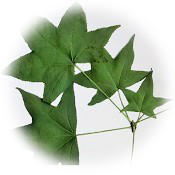 The bark is brown, shallow and longitudinal. The flowering season is around April. The bark is brown, shallow and longitudinal. The flowering season is around April.
It is a neat tree shape, with a variety of autumn leaves from green to yellow to yellow to orange to red, so it can be compared to "seven colors of autumn leaves".
The colors differ one by one depending on the trees, and even among the trees, there is a difference in the degree of autumn leaves, and it creates an autumn outfit like Nishiki woven.
It shows changes in various shades, shines in the sunshine and adds color to competition.
The fruit of "Iga" with a long pattern that remains on the branches even after deciduous leaves is also unique.
[Sam]
14:00 on November 18, 2016
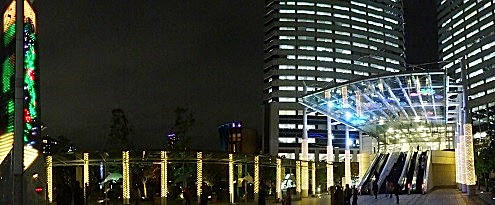
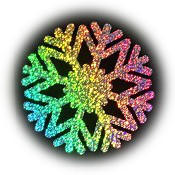
On November 16, at Harumi Triton Square, the year-end annual "Winter Illumination 2016" lights up.
It is shining in the background of high-rise buildings.
Exhibition Period: November 16 to February 14, 2017
Until two years ago, fantastic LED illuminations based on blue were developed, centered on the "water terrace", with the motif of the ocean blue oceans and dolphins, but this year, the entrance of North Triton Park since last year, Triton Bridge Following the illumination of champagne gold centered on.
The illuminations of Triton Bridge are also organized in a simple tone this year.
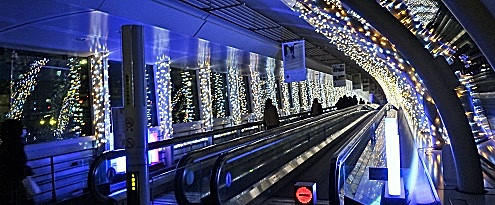
[Sam]
09:00 on November 17, 2016
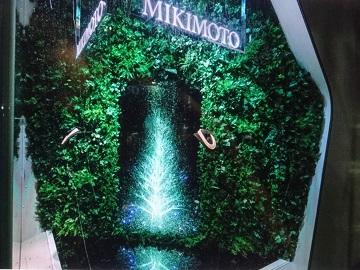
With the rebuilding of the Mikimoto Main Store Building in Ginza 4-chome, MIKIMOTO Ginza 2 along Namiki-dori St. is open as Mikimoto Ginza 2-chome Main Store, but on November 11, the 2016 Christmas special display started at the show window.
The theme is "Sparkling Dream Tree".
Exhibition Period: November 11 to December 25, 10:00 to 23:00
Last year, an artistic world that combines delicate paper craft and projection mapping was unfolded, but this year we produced a holiday season display in collaboration with TeamLab.
The teamLab expresses the founder's desire to decorate women around the world with pearls of light, a special winter-only interactive work that expresses the desire of the founder with pearls.
It is the season when the city is shining.
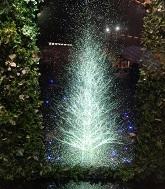 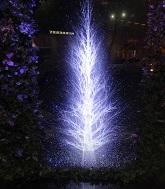 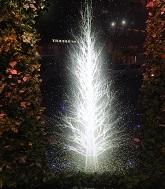
[Sam]
12:00 on November 16, 2016
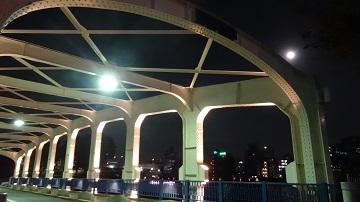 "Super Moon" on the night of November 14th, which is hot for the first time in 68 years since 1948. "Super Moon" on the night of November 14th, which is hot for the first time in 68 years since 1948.
A phenomenon in which the moon orbiting around the earth overlaps with the day when the closest approach to the earth and the full moon, and the moon seen from the earth looks larger than usual.
According to the National Astronomical Observatory of Japan, the distance between the earth and the moon is about 384,400 km, but on the night of the 14th, it approached about 356,500 km, and it is 1.14 times the diameter and the area is about 30% larger than the full moon on April 22, which was the smallest of this year.

It is said that the distance at the time of approach changes every year due to the influence of the gravity of the sun, but the next opportunity to approach this far is 2034.
The weather was unfortunate on the day, but even before and after the 14th, a moon with a large appearance could be seen over the lit up Toyomi Bridge.
Tonight, November 15th is sixteen nights, not a full moon, but the difference is small.
There are many clouds and it will soon fade, but I was able to enjoy the "Super 16 Night" that occasionally shines brightly.
|
Links
|
 The yellow leaf front of the ginkgo, which has advanced from the north, also reached Tokyo.
The yellow leaf front of the ginkgo, which has advanced from the north, also reached Tokyo. Great Kanto Earthquake in the Omote moat green area (commonly known as Kiyomaro Park) at the northeastern end of the Imperial Palace.
Great Kanto Earthquake in the Omote moat green area (commonly known as Kiyomaro Park) at the northeastern end of the Imperial Palace. On November 17, the Chuo-ku Machikado Exhibition Hall Tour-Experience the state-of-the-art world of medicine and the long-established tradition-hosted by the Chuo-ku Machikado Exhibition Hall Management Council was held.
On November 17, the Chuo-ku Machikado Exhibition Hall Tour-Experience the state-of-the-art world of medicine and the long-established tradition-hosted by the Chuo-ku Machikado Exhibition Hall Management Council was held. At the Daiichi Sankyo Medicine Museum, after watching a video of "one medicine" on a round monitor in the center of the lounge on the 1st floor, you will receive a medal with an IC chip and go to the 2nd floor.
At the Daiichi Sankyo Medicine Museum, after watching a video of "one medicine" on a round monitor in the center of the lounge on the 1st floor, you will receive a medal with an IC chip and go to the 2nd floor. November is also in the middle of November, and the morning and evening are colder day by day, and the Kiki gradually turns color, and it is at their best.
November is also in the middle of November, and the morning and evening are colder day by day, and the Kiki gradually turns color, and it is at their best. The bark is brown, shallow and longitudinal. The flowering season is around April.
The bark is brown, shallow and longitudinal. The flowering season is around April.






 "Super Moon" on the night of November 14th, which is hot for the first time in 68 years since 1948.
"Super Moon" on the night of November 14th, which is hot for the first time in 68 years since 1948.

